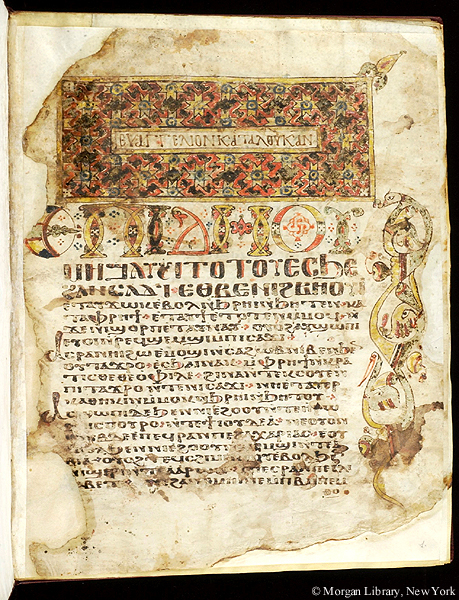
Manuscript gospels of Luke and John, written in Egypt.
Sewing repairs on fols. 31 and 32.
46 of the first 88 leaves, or 11 quires are wanting. Luke wants 34 or 35 leaves (24 between fols. 16 and 17, 1 between fols. 19 and 20, 7 between fols. 23 and 24, 2 or 3 after fol. 24 to complete the quire); John wants more than 9 leaves (5 or 6 leaves before fol. 25 to complete the quire, 2 between fols. 40 and 41, two between fols. 41 and 42, and several leaves after fol. 42).
Written area ca. 301 x 226 mm. Divisions: ekthesis, major initial, line of enlarged letters, and paragraphus sign (large vine-scroll coronis with bird on 7 fols.) setting off major textual units; ancient Greek and Coptic chapter numbers (in red and black respectively) located on rectos within major initial (if shape permits) or above it, and within coronis on versos; ekthesis and reddened enlarged initial, sometimes with bird, setting off paragraphs. Exceeding letters of last line of the page written below end of the line on rectos of fols. 1, 6, 12, 15, 23, 26, 27, 31, 33 and on versos of fols. 6, 7, 10, 14 and 18.
Script: Same hand as M.616; Upright. 10 lines = ca. 89 mm
Superlineation: Old-style jinkim system. Punctuation: Raised dot in conjunction with a reddened dotted diple and a space.
Collation: Probably signed on first and last page of the quire, top inner margin. No remains of signatures (all top inner margins wanting). Quire ornaments. Monograms on first and last page of the quire. Headlines. No catchwords.
Marginal annotations: on fols. 6r and 7r next to a coronis; on fol. 10v in Arabic: "second Sunday of Baʼūna (May 26-June 24 Julian) and Copto-Arabic numbers added later (not part of the original kephalaia numbering).
Corrections: Sublinear and superlinear additions in small letters.
Scribe: Biktōr?
Decoration: Headpiece, paragraphus signs, coronis, initials, page numbers. Colors: Dark reddish orange (Centroid 38), strong yellow (84), moderate yellowish green (120), blue (chemically altered).
Related fragments possibly include: M.616. According to Hyvernat, 1935, p. 29, n.2, "[M.616] and [M.617], when purchased, formed one package. They have been separated on the strength of the fact that each of the two bears its own distinct pagination. But upon closer examination of the two, there seems to be good ground to admit that they originally formed but one volume, or at least were long kept as one volume."
